Are you a Quiet Speculation member?
If not, now is a perfect time to join up! Our powerful tools, breaking-news analysis, and exclusive Discord channel will make sure you stay up to date and ahead of the curve.
Today finally brings an update to the metagame breakdown, with data from December. I know many of our readers have been very disappointed to see these fall by the wayside—I want to explain briefly why I've been lagging on them, and reassure you that they will be back in full force for 2017. I recently began a new job that has made it hard to keep up, but my schedule is much more settled now, and you can expect regular metagame updates on time again. That said, this one will be a little different, since the greater lag time will mean a bigger jump in metagame shifts. I decided a clean break was better than trying to slog through three months of data (and delaying the publication further). For now, let's see how Modern has changed in the intervening months. (Spoiler alert: it's the same format we know and love.) I'll close with some discussion of the Golgari Grave-Troll and Gitaxian Probe bannings that just came down the line from WoTC.
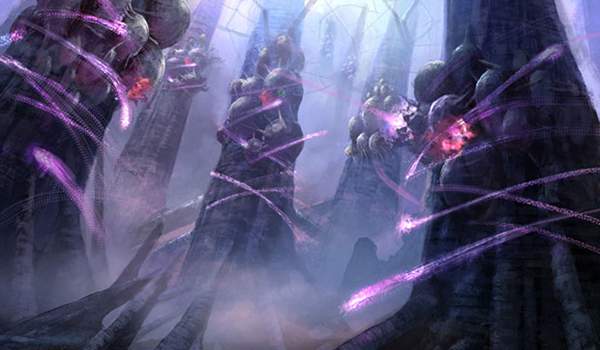
December in many ways shows Modern in characteristic form. Infect is the clear top dog, much as many pros have claimed, clocking in at 10.2%. While this is significantly higher than the next archetype in line (Jund, surprise, surprise, at 7.5%) it also doesn't represent an unassailable position. Earlier in 2016 we saw several months where other archetypes posted similar levels of dominance. September saw Bant Eldrazi at the top with 9.2%, whereas in July and August Jund hovered around the 10% mark—with an even bigger drop-off to the second-place deck than we see today with Infect.
Even if these months are a ways behind us, the takeaway is the same: Modern is in a (relatively) healthy place, and today's best archetype might be tomorrow's second fiddle. That said, Infect's dominance is of much more concern than Jund's or Eldrazi's, in accordance with the turn four rule laid out by Wizards. My prediction was for no changes to the banlist—a position refuted earlier today with Wizards's B&R announcement—but the data from December clearly show Infect in dangerous territory. We'll discuss more below why its dominance is more actionable than that of Jund or Eldrazi, and why Dredge got the axe alongside it.
[wp_ad_camp_1]
Data Collection Methods
First off, a reminder of our methods for collecting metagame data and the sources involved. For paper events we're drawing from 62 tournaments the world over for a total of 426 decks. Major events from December were the Star City Games Atlanta Invitational and an SCG Classic in the same city. To cast a wider net, these have been amalgamated with major event data from November (an SCG Open in Columbus and two Classics in Baltimore and Knoxville), which do not appear in the paper data at large.
Finally, the SCG Players' Championship contained a minor Modern portion, which we reported as a major paper event. As the Modern portion only comprised three rounds, I only included decks that managed a perfect record, for three entries total. In any case, these three decks were unlikely to shift things fundamentally, especially since they were all Tier 1 and 2 mainstays (Burn, Dredge, and Grixis Delver).
MTGO events included three PTQs. One was the traditional fare run in the online client, while the other two were Regional PTQs made available to qualified players who found travel to a live event difficult or undesirable. In addition, we have the regular battery of Competitive League finishes (one per day) for a total of 34 events and 398 decks.
All in all, we're working with 824 decks total in December. These were weighted using Sheridan's formula to generate the tierings you see below.
Tier 1
Tier 1 decks are the ones you should expect to face at every Modern tournament. Make sure you show up to your local events and Grand Prix alike with a well thought-out plan to beat these decks—you’re going to face them often, and each one is resilient enough to fight through a lackluster counterplan. Of course another avenue is to pick one of these up yourself, which I generally suggest for anyone not well-versed in a lower-tier deck. Whether you know one of these archetypes inside-out and can tune a killer sideboard for the field, or you want to pick up something new and wing it, these decks certainly have the chops to get the job done.
Tier 1: 12/1/16 - 12/31/16
The biggest story here is obviously Infect's uncontested position atop the standings. Much like with Jund's reign earlier this year, I believe we would have seen the metagame adapt to respond to Infect's dominance, but the bannings will make it hard to disentangle the different effects in the coming months. 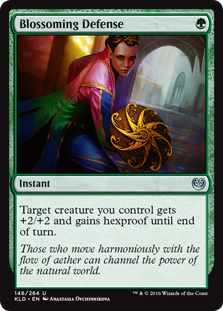 In any case, many of the best players in the game have been calling Infect the best deck in Modern, and for December at least it appears to be true. The arrival of Blossoming Defense most likely has played a part, but so has Dredge's rise. Infect is, of course, one of the best answers to the graveyard menace, which is still posting a 6.8% metagame share despite the giant target on its head and the supposed effectiveness of the hate cards.
In any case, many of the best players in the game have been calling Infect the best deck in Modern, and for December at least it appears to be true. The arrival of Blossoming Defense most likely has played a part, but so has Dredge's rise. Infect is, of course, one of the best answers to the graveyard menace, which is still posting a 6.8% metagame share despite the giant target on its head and the supposed effectiveness of the hate cards.
The rest of Tier 1 is the typical offering we've come to expect in Modern. Burn and Affinity complement Dredge and Infect in the aggro spot, with Jund and Bant Eldrazi checking linear aggro, and Tron pulling up the rear as a check on midrange. Abzan has fallen off, but it's hovering just beneath the Tier 1 cutoff at 3.8%. Like I said, same old Modern.
Tron, for its part, has exhibited significant innovation over the last few months, reflected in my new reporting of all green Tron variants under "Gx Tron." This includes four different builds of the deck, which I contend are fundamentally the same archetype: Mono-G, RG, GW, and newcomer BG Tron as pioneered by Joe Lossett. In each of these cases, the main difference in lists is which removal/interaction spell they've chosen to run—Fog, Lightning Bolt, Path to Exile, and Collective Brutality each respond to different metagame conditions, but the main shell of the deck remains constant. 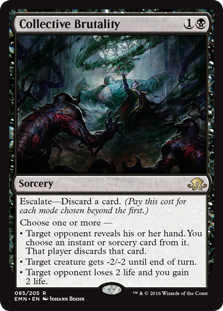 Compare this to something like Abzan vs. Jund, which ends up shifting a large number of cards in the change over to a different splash color, or the other Tron decks (Mono-U and Eldrazi Tron) which are pretty clearly distinct.
Compare this to something like Abzan vs. Jund, which ends up shifting a large number of cards in the change over to a different splash color, or the other Tron decks (Mono-U and Eldrazi Tron) which are pretty clearly distinct.
As it stands, dividing the green Tron decks further we see that the white version has cannibalized a chunk of RG's traditional metagame share. At 2.1% and 1.3% respectively, these two versions handily dwarf the black variant's 0.4% share. I attribute the rise of white to Path to Exile's superior ability to handle the threat base presented by linear aggro. With the exception of Affinity, this is Tron's traditional Achilles heel, and it has had to adapt to the ascent of Dredge, Infect, Death's Shadow Zoo, and UR Prowess during the course of 2016. It will be interesting to see how BG Tron develops in the coming months (I think it's too new for players to have adopted it en masse at this time) but if Infect recedes in the wake of the ban we may see a corresponding decrease in Collective Brutality's stock.
Tier 1 Changes: September to December
If these differences look large, remember that we're looking at a change over several months. Infect and Dredge are up (confirming the community's perception of their strength), Bant Eldrazi and Affinity are down. I'm a little perplexed to see Burn lose share as Infect rises, but it's hard to see exactly how this went down over the last couple months, and in any case it's still posting a robust 6.9%. 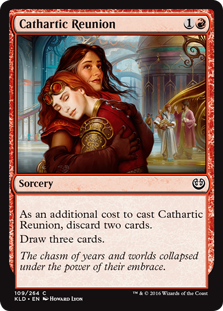 Again, regarding Dredge, it's notable that the total share has increased over the last few months, when such powerful sideboard cards are available and it's on everyone's radar. Dredge was already doing pretty well before the release of Kaladesh gave it an explosive new tool in Cathartic Reunion. We'll touch more on the implications of this in the discussion below on the banlist changes.
Again, regarding Dredge, it's notable that the total share has increased over the last few months, when such powerful sideboard cards are available and it's on everyone's radar. Dredge was already doing pretty well before the release of Kaladesh gave it an explosive new tool in Cathartic Reunion. We'll touch more on the implications of this in the discussion below on the banlist changes.
Bant Eldrazi's 5% fall is obviously the biggest news here. While it occupied the top spot in September, this change may be partly attributable to another deck we'll see below in Tier 2, Eldrazi Tron. In any case, the combined metagame shares of both Eldrazi decks still represent a marked drop since September. As far as I'm concerned, Jund is the more robust, less hateable midrange deck overall, but at 4.3% of the metagame, Bant Eldrazi is no slouch.
Tier 2
Tier 2 decks are not as omnipresent as the Tier 1 crop, but they still show up in hearty numbers at the typical tournament. In many ways this tier is the lifeblood of Modern, whence its diversity and “play anything” reputation stems. If these decks aren’t dominating at the moment, they’re still capable of crushing a tournament on any given day—and many of them have been Tier 1 at some point in the past or will in the future. The better acquainted you are with any one of these archetypes, the better choice it represents, and if one of them is your specialty there’s a strong argument to stay the course and keep sleeving it up.
As for preparing to beat Tier 2 decks, you don’t need to dedicate specific sideboard space or do backflips to make your matchups favorable, but at minimum have a plan. You won’t face all of these decks in a tournament, but you’re all but certain to face at least some of them. Welcome to Modern!
Tier 2: 12/1/16 - 12/31/16
Some shake-ups to Tier 2 have certainly occurred over the last few months. Before we get to those, there were a few minor movements in more established archetypes. We see Eldrazi Tron become an archetype in its own right with a 1.6% share, possibly supplanting some of the Bant Eldrazi decks as mentioned above. Death's Shadow Zoo has risen to about double its share in September. Finally, the RG Valakut variants seem to have switched places for some reason. In September, Titan Breach held the larger share (3.4% to Titan Shift's 1.6%) whereas now Titan Shift comes out on top (2.8% to 1.7%). To me this just drives home the idea that the two Valakut strategies, despite making use of a slightly different spell suite, play fundamentally the same game and occupy similar metagame space. The one that comes out on top in any given month may be due to little more than which is in vogue.
The changes to Tier 2 are really highlighted by the arrival of some new players: Lantern Control, RW Prison, and UR Prowess. The former has been a known Modern deck for some time, often championed by pros who have claimed it's underplayed. RW Prison and UR Prowess are newer decks, and their metagame share here indicates they are real contenders.
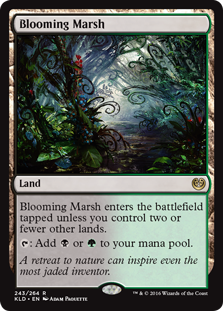 Lantern Control benefits from new tools. The bizarre prison deck brought into the limelight by Zac Elsik a couple years back has benefited from two prominent printings in 2016: Collective Brutality and Blooming Marsh. Brutality helps the deck shore up some of the its major weaknesses. It kills utility creatures that can laugh off an Ensnaring Bridge, snags interaction pieces that have snuck under the draw-step lock, or gains some critical life against Burn. That's a ton of value in a two-mana spell, especially when the discard is an additional boon for a deck aiming to get hellbent. Blooming Marsh is a lot less sexy, to be sure, but it's no coincidence that most Lantern lists have adopted it as a four-of. When you're trying to drag the game out to infinity without playing any traditional defenses or creatures of your own, life loss from a painland adds up fast.
Lantern Control benefits from new tools. The bizarre prison deck brought into the limelight by Zac Elsik a couple years back has benefited from two prominent printings in 2016: Collective Brutality and Blooming Marsh. Brutality helps the deck shore up some of the its major weaknesses. It kills utility creatures that can laugh off an Ensnaring Bridge, snags interaction pieces that have snuck under the draw-step lock, or gains some critical life against Burn. That's a ton of value in a two-mana spell, especially when the discard is an additional boon for a deck aiming to get hellbent. Blooming Marsh is a lot less sexy, to be sure, but it's no coincidence that most Lantern lists have adopted it as a four-of. When you're trying to drag the game out to infinity without playing any traditional defenses or creatures of your own, life loss from a painland adds up fast.
It's possible that metagame conditions are helping Lantern in no small measure, but I can't for the life of me imagine what the major difference between December and September would be. Tier 1 hasn't really changed very much, after all. I'd be interested to hear in the comments if anyone has insight into how Lantern might be well positioned currently, but for now I'm inclined to believe it's simply a stronger deck than before.
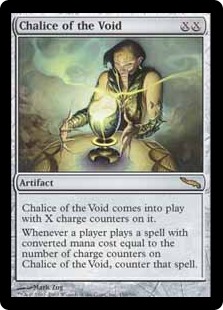 Sun and Moon overcomes its middling fringe status. The unlikely control strategy debuted earlier this year under the name "RW Lockdown," and has since come a long way. Yep, it's a red-white control deck. Yep, it has access to both Path and Bolt, the uncontested best removal spells in the format, and chooses to run neither. Yep, it has gradually grown in metagame share to 2.3% in December, falling solidly in Tier 2.
Sun and Moon overcomes its middling fringe status. The unlikely control strategy debuted earlier this year under the name "RW Lockdown," and has since come a long way. Yep, it's a red-white control deck. Yep, it has access to both Path and Bolt, the uncontested best removal spells in the format, and chooses to run neither. Yep, it has gradually grown in metagame share to 2.3% in December, falling solidly in Tier 2.
I still feel incredibly awkward about Star City Games' chosen moniker ("Sun" because of the white mana symbol? Wouldn't that encompass tons of other decks too?), but I'll concede it's catchy as all get-out. I still like calling it RW Prison, to differentiate it from other midrange control decks and highlight the particular way it plans to win: with cheese-you-out permanents extraordinaire Blood Moon and Chalice of the Void. We've long known as Modern players and commentators that Blood Moon is a beating in any fetch/shock format trying to max out on splashes. Chalice, on the other hand, has been pretty underplayed during much of Modern's reign in my opinion. We lack the Sol lands that enable its early deployment in Legacy and Vintage (although Simian Spirit Guide does its best impression), but a format as efficient as Modern certainly boasts a large number of one-drops—making Chalice a potential ten-for-one (or more!) against any number of strategies.
Personally I'd still be leery of picking up this deck—mainly because it's a control deck lacking library manipulation—but it obviously has the goods to put up reasonable finishes. Lock pieces against combo and control, check. Sweepers galore against the aggro decks, check. Quick win condition in good old Nahiri fetching Emrakul, check. I suspect we haven't seen the last of RW Prison, even if it is mighty strange to see a red-white deck foregoing both Path and Bolt.
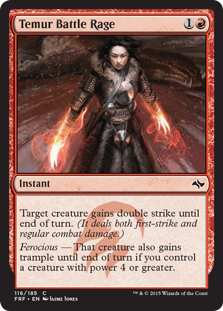 Death's Shadow Blue, the other Battle Rage deck. Another major story in 2016 was the rise of Death's Shadow Aggro, and the wider adoption of Temur Battle Rage and Become Immense. Infect has long used the delve spell, but players started to figure out other uses for it, including decks that could port over the full Standard combo. Eventually, someone realized that Monastery Swiftspear was contributing enough wins to the Death's Shadow deck and asked, "What if we just cut all that other stuff?" Cue the appearance of "Death's Shadow Blue," or UR Prowess. Back in September it was rounding out the bottom of Tier 3 at 0.3%, but by December its share has grown to 2.2%.
Death's Shadow Blue, the other Battle Rage deck. Another major story in 2016 was the rise of Death's Shadow Aggro, and the wider adoption of Temur Battle Rage and Become Immense. Infect has long used the delve spell, but players started to figure out other uses for it, including decks that could port over the full Standard combo. Eventually, someone realized that Monastery Swiftspear was contributing enough wins to the Death's Shadow deck and asked, "What if we just cut all that other stuff?" Cue the appearance of "Death's Shadow Blue," or UR Prowess. Back in September it was rounding out the bottom of Tier 3 at 0.3%, but by December its share has grown to 2.2%.
While this deck usually doesn't have access to Become Immense itself (although green-splash versions do exist), it can cobble together the necessary power with Mutagenic Growth and of course the prowess mechanic itself. The creatures lost in Tarmogoyf, Steppe Lynx, Wild Nacatl and Death's Shadow are replaced with Thing in the Ice and Kiln Fiend. What you end up with is a less explosive deck, but one that's both more forgiving and less susceptible to Burn. My guess is that the traditional Death's Shadow deck still outclasses this one—especially if you're a world-class player who can navigate its treacherous lines—but UR Prowess has come into its own.
Tier 3
Tier 3 in Modern houses the decks with fringe potential, or those which are simply in a poor position in the current metagame. These decks range from relatively strong decks with scant adoption in the player base, to fragile decks that crumble to variance while mainstays like Burn or Jund draw consistently round after round. That said, Modern draws from an absurd well of card power, and each of these decks can give you a run for your money. You don’t need perfect knowledge of everything they’re doing, but the difference between familiarity and complete ignorance can definitely determine the outcome of a match.
Playing these decks isn’t advised, unless you know them inside-out or have some specific reason why you think they’re underrepresented. Of course, they are also worth a look as fun decks to battle if you’re less concerned about winning and want to delve into the deeper end of the Modern pool.
Tier 3: 12/1/16 - 12/31/16
As with the first two tiers, Tier 3 bears a lot of resemblance to its profile from three months ago. A few newcomers from back then are still posting similar numbers, like Amulet Titan, Knightfall, and Pyromancer Ascension. I think it's fair to say these decks are here to stay, albeit not likely to take the metagame by storm anytime soon. By now the community has had time to try them out, tweak them, and put them through their paces—it appears they have what it takes to succeed with some consistency, but not to excel.
Other than that, we see UW and Jeskai strategies of various stripes continue to post results in December, while Eldrazi and Taxes and Abzan Company have slid down the rankings slightly since September. Blue Moon is also back. Let's take a look at each.
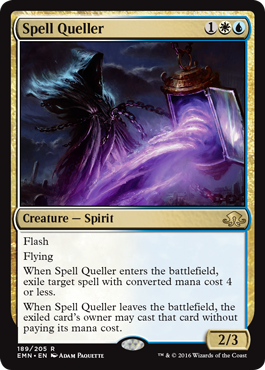 UWx midrange is splintered across several decks. Jeskai Nahiri (which we've often reported as Jeskai Control) is a well-established archetype that varies only slightly in build from pilot to pilot. Jeskai midrange decks have been a much bigger challenge to classify, presenting a wide range of variation that really falls along a continuum from midrange to control. This is all complicated by the relatively new arrival of blue-white midrange and control decks, which share a lot in common with their more storied Jeskai siblings.
UWx midrange is splintered across several decks. Jeskai Nahiri (which we've often reported as Jeskai Control) is a well-established archetype that varies only slightly in build from pilot to pilot. Jeskai midrange decks have been a much bigger challenge to classify, presenting a wide range of variation that really falls along a continuum from midrange to control. This is all complicated by the relatively new arrival of blue-white midrange and control decks, which share a lot in common with their more storied Jeskai siblings.
For now I'm grouping the blue-white decks together in one category—like the non-Nahiri Jeskai decks, it can be hard to differentiate between the two. UW Control tends to run more spells like Cryptic Command, Sphinx's Revelation, and planeswalkers. UW Midrange makes more prominent use of creatures like Restoration Angel, Spell Queller, Kitchen Finks, and Snapcaster Mage. These decks (and their Jeskai corollaries) are sometimes reported under the name "Flash," and that's probably an apt description of their play pattern. There appears to be a pretty smooth gradient between the more controlling and more "flashy" builds at this time—perhaps time and testing will sift them out into more defined archetypes, as we saw with Valakut strategies last year. In any case, it should be obvious that these decks are competing with each other for metagame share—although I do consider Lightning Bolt and Nahiri, the Harbinger two pretty strong arguments for the superiority of Jeskai.
One final note on Jeskai decks: note the first appearance here of Jeskai Aggro, which manages to claim a 1% share all on its own. This is the Mantis Rider deck, which appears to have debuted with a close-to-consensus build (and occupies a very different metagame position). The deck plays other aggressive creatures like Goblin Guide and Stormchaser Mage, with Snapcasters at the top of the curve to flash back a lethal Lightning Helix or the like. These are pretty clearly distinct from the Jeskai Prowess deck, which is much more closely aligned with UR Prowess. The latter two could well be grouped under the same archetype if we were so inclined, as white provides little more than a splash for Helix, and sometimes Monastery Mentor.
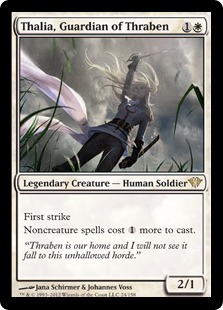 Eldrazi and Taxes slides farther down the rankings. In past updates I've called this deck Death and Taxes and grouped it together with other Leonin Arbiter/Thalia, Guardian of Thraben decks. Practically speaking, the black-white Eldrazi version is the de facto consensus build, with mono-white, GW, and occasionally UW versions appearing much more infrequently. Furthermore, especially when we look at the green-white decks, there's a ton of variation and an unclear difference between GW Hatebears and GW Aggro. For now I prefer to report them separately as Eldrazi and Taxes and Hatebears. My theory is that Thalia simply pairs better with Thought-Knot Seer et.al. than with Noble Hierarch and Collected Company, and a prison-like creature deck gets a pretty big shot in the arm from giant walking Thoughtseizes and the board-dominating Eldrazi Displacer. Add Tidehollow Sculler and Wasteland Strangler into the mix, and I'm hard-pressed to see how a board-control deck would rather give all that up for a clunky beatstick like Loxodon Smiter. Either way, it doesn't seem like a great time for Thalia in general.
Eldrazi and Taxes slides farther down the rankings. In past updates I've called this deck Death and Taxes and grouped it together with other Leonin Arbiter/Thalia, Guardian of Thraben decks. Practically speaking, the black-white Eldrazi version is the de facto consensus build, with mono-white, GW, and occasionally UW versions appearing much more infrequently. Furthermore, especially when we look at the green-white decks, there's a ton of variation and an unclear difference between GW Hatebears and GW Aggro. For now I prefer to report them separately as Eldrazi and Taxes and Hatebears. My theory is that Thalia simply pairs better with Thought-Knot Seer et.al. than with Noble Hierarch and Collected Company, and a prison-like creature deck gets a pretty big shot in the arm from giant walking Thoughtseizes and the board-dominating Eldrazi Displacer. Add Tidehollow Sculler and Wasteland Strangler into the mix, and I'm hard-pressed to see how a board-control deck would rather give all that up for a clunky beatstick like Loxodon Smiter. Either way, it doesn't seem like a great time for Thalia in general.
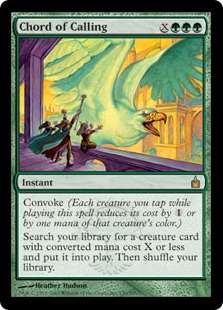 Green-based toolbox strategies continue to languish. Kiki Chord and Abzan Company have been dropping off gradually for some time, and since September we've seen the Abzan shells shed about half their metagame share. Now Abzan Company and Evolution decks combined only make up 0.9% of the field, while Kiki-Jiki Chord decks add in another 1%. Most of the experimentation with Eldritch Evolution seems to have run its course, with most Abzan players returning to the traditional duo of Collected Company and Chord of Calling. Kiki Chord still uses the Eldritch card, however, so it doesn't appear that its adoption was purely conventional, or unwarranted. Now that Dredge is being nerfed, it will be interesting to see if the toolbox strategies (which rely at least partially on graveyard shenanigans) can make a comeback.
Green-based toolbox strategies continue to languish. Kiki Chord and Abzan Company have been dropping off gradually for some time, and since September we've seen the Abzan shells shed about half their metagame share. Now Abzan Company and Evolution decks combined only make up 0.9% of the field, while Kiki-Jiki Chord decks add in another 1%. Most of the experimentation with Eldritch Evolution seems to have run its course, with most Abzan players returning to the traditional duo of Collected Company and Chord of Calling. Kiki Chord still uses the Eldritch card, however, so it doesn't appear that its adoption was purely conventional, or unwarranted. Now that Dredge is being nerfed, it will be interesting to see if the toolbox strategies (which rely at least partially on graveyard shenanigans) can make a comeback.
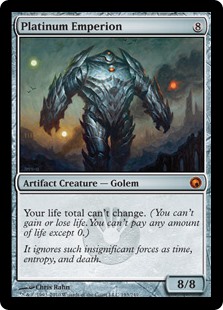 Madcap Moon rears its head. Kaladesh introduced a brand new combo to Modern in the form of Madcap Experiment and Platinum Emperion. The way the timing works, you can reveal any number of cards to the Experiment and it won't hit you with the damage until Emperion is already in play. A couple other decks have tried to adopt the combo (RG Ponza, Titan Breach) but it seems to be finding the most success in Blue Moon. Like many control decks in Modern, Blue Moon has the age-old problem of losing the topdeck war after stabilizing. Perhaps like Jeskai Nahiri before it, its newfound win condition has been responsible for putting it back on the Tier 3 map at 1.2%. That said, Blue Moon was posting similar numbers back in June, so maybe metagame conditions have become favorable again.
Madcap Moon rears its head. Kaladesh introduced a brand new combo to Modern in the form of Madcap Experiment and Platinum Emperion. The way the timing works, you can reveal any number of cards to the Experiment and it won't hit you with the damage until Emperion is already in play. A couple other decks have tried to adopt the combo (RG Ponza, Titan Breach) but it seems to be finding the most success in Blue Moon. Like many control decks in Modern, Blue Moon has the age-old problem of losing the topdeck war after stabilizing. Perhaps like Jeskai Nahiri before it, its newfound win condition has been responsible for putting it back on the Tier 3 map at 1.2%. That said, Blue Moon was posting similar numbers back in June, so maybe metagame conditions have become favorable again.
Banned & Restricted Changes
Finally, let me touch briefly on the changes to the banlist Wizards announced earlier today. If you somehow don't know by now, Gitaxian Probe and Golgari Grave-Troll are no more in Modern. I had already planned a couple articles on banlist predictions and the philosophy behind the Modern format for the coming weeks, and this means I have some more to think on. 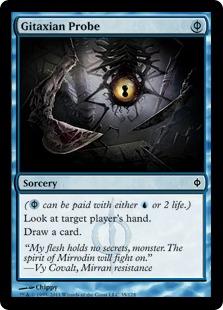 The announcement has obviously precluded banlist speculation, but we have a lot to discuss about what it all means moving forward.
The announcement has obviously precluded banlist speculation, but we have a lot to discuss about what it all means moving forward.
The first thing to note is that neither Infect nor Dredge were putting up the kind of format-warping percentages of the most recently banned offender, Eye of Ugin. Infect was far-and-away the best deck in December, but so was Jund in July and August. Both claimed around 10% of the field during their height. Dredge is behind Burn and Jund in the month of December. So if these decks aren't crushing diversity or crowding other decks out of the format, why did they get nerfed?
For Infect, it's a clear application of the turn four rule. Remember, for a deck to qualify as an offender is this area, it must not just be capable of turn-three wins in theory. It has to do that with a modicum of consistency, and be resilient enough to withstand hate aimed at it. The likes of Grishoalbrand are far from meeting the banhammer's wrath, as decks like that simply don't put up the metagame shares to be considered problematic. Infect, on the other hand, was highly lauded by a wealth of pros and grinders as the best deck in the format, confirmed roundly by its share of the December metagame. 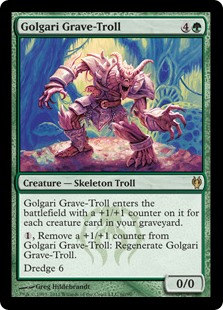 And those turn-three kills are real (turn two much less so, one of the reasons I found calls for a Mutagenic Growth ban a little odd). The issue isn't so much that Infect can do it, it's that it does do it—sometimes through significant disruption. The other day at my local game store I ended a hapless opponent on turn three through his on-curve Thalia. Turn one Noble Hierarch, turn two land, Blighted Agent, turn three land, Growth, Become Immense. Good game (or not).
And those turn-three kills are real (turn two much less so, one of the reasons I found calls for a Mutagenic Growth ban a little odd). The issue isn't so much that Infect can do it, it's that it does do it—sometimes through significant disruption. The other day at my local game store I ended a hapless opponent on turn three through his on-curve Thalia. Turn one Noble Hierarch, turn two land, Blighted Agent, turn three land, Growth, Become Immense. Good game (or not).
This is just a textbook case of a turn four rule violation. Infect certainly has some bad matchups such as Burn, Jund, and Abzan, and beating it is possible if you choose to pilot one of those decks. But its ability to win before the allowed time frame with consistency means an enormous pressure placed on other decks—one Wizards deemed too oppressive. Note that they didn't ban one of the cards that contributes most to Infects speed per se, but rather a tool that lets it win through disruption. They've endeavored not to kill the deck, but simply to make it more fair, and easier to combat. I assume this means that they believe less perfect information in the hands of Infect pilots will lead to more blowouts via Path to Exile, Deflecting Palm, Blessed Alliance, Fog, etc.
Golgari Grave-Troll is another story. The Dredge deck can rarely win on turn three, but it can definitely create an insurmountable advantage by then. While Infect is susceptible to particular archetypes, Dredge folds to particular cards: Surgical Extraction, Rest in Peace, Ravenous Trap, etc. 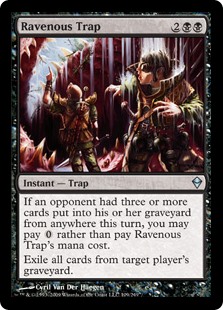 But just like Infect, Dredge has managed to put up numbers over and over in spite of the relatively large target on its head. If it isn't in violation of the turn rule itself, it creates the same kind of pressure on any lower-tier deck trying to compete. Dedicate sideboard space or perish. Or perish anyway, because Dredge is strong even through the hate.
But just like Infect, Dredge has managed to put up numbers over and over in spite of the relatively large target on its head. If it isn't in violation of the turn rule itself, it creates the same kind of pressure on any lower-tier deck trying to compete. Dedicate sideboard space or perish. Or perish anyway, because Dredge is strong even through the hate.
Wizards must have believed the warping effect of Dredge in the format was pretty significant, as they end up with some egg on their face having unbanned Grave-Troll a few years earlier. I've long claimed that I think the deck is an abomination, so I'm happy to see their uncounterable, zero-mana, repeatable draw-six removed from the format. The deck probably won't disappear entirely, but I expect it not to hold onto the Tier 1 status it has enjoyed. Infect is much more likely to weather the banning storm, although new kid on the block Fatal Push is certain to have something to say on that matter as well.
Back on Track
As I said in the introduction, I will be working very hard to address everyone's concerns here at Modern Nexus in the coming year. This means more regular metagame updates, Monday articles, and greater attention paid to quantitative analysis. It also means the roll-out of the primers. We have made substantial progress on those, but I want to make sure to put the right foot forward when we publish them, so I've delayed making anything public. Expect something concrete on that front this spring.
Thanks for reading, and I hope you'll continue to do so in the new year.


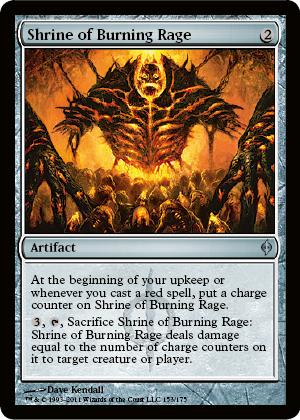



Great to have the Metagame updates back Jason! I hope you’re also enjoying your new job.
Thank you for the transparency about the delay. I know a lot of us were champing at the bit for a new update (me definitely included!) but knowing that you guys are listening is a great relief.
Real bad luck that the timing of Wizards announcement steals the limelight of the metagame update, but the adjustments after the bannings will make the next update more important than ever.
Fantastic article jason, especially considering you added or rewrote portions to reflect yesterdays surprise ban update.
The next update will be extremely valuable in informing us on what the bans and fatal push mean to the format, so very much looking forward to that and seeing where dredge and infect land and whether modern will be a tron and valakut world now.
Hey guys! I just finished building UR Prowess aaaaaaaaaaaaaaaaaaaaand it’s gone. Good thing a lot of those cards have value in other decks.
“Created by Zac Elsik”
One of you is a moderator in the forum where the deck was created, and have an article about the creation of the deck, and still got this wrong?
This is crexalbo from the mtgsalvation forums.
I got this wrong the first time i looked at it, too. Zac Elsik popularized the deck with his GP win, but it was zerodown who came up with the original idea. It’s been worked on by multiple individuals ever since.
Also, i’d argue that Inventors’ Fair was the real catch from Kaladesh, not Blooming Marsh. Fair gave us maindeck life gain for aggressive decks, coupled with a tutoring effect for when the game goes long. It’s now a stock 2-of in virtually every list for the resilience and consistency it provides.
Also, new tech was recently discovered by kanister in the form of Mishra’s Bauble. They have been popularizing a low-to-the-ground Golgari build that focuses on consistency in the early game by using Baubles combined with mill rocks to use the card to look deeper than possible with other decks.
I’d personally say that the deck’s success is due in large part to the printings of Collective Brutality and Inventors’ Fair, and the adoption of Mishra’s Bauble. Marsh did provide a painless source of the deck’s primary colors, but that wasn’t as much of a boon as the other cards.
People using Mishra’s Bauble for its peek effect. What a format!
Thank you for pointing out the error. It has been corrected.
So there were turn four rule offenders this time. Did we ever get the numbers of Infect, Death’s Shadow Zoo and UR Prowess? I remember an article here predicting Summer Bloom’s ban due to having pre-turn 4 kills about 25% of the time. I missed a similar article for these aggro decks here in Modern Nexus.
I will have to go back and read that article, which was published before I came to Nexus. Assuming I can replicate the experiment, that is something we’ll look to do in future.
Aaaaaaaand we’re back! Glad to have this with us to ring in the new year, especially to illuminate the standing of some of the decks that have had poor online showings but solid paper ones, or vice versa. Thanks for the work that’s been put in.
As for the bans… they’re clearly geared at making the format a bit slower, and I think they mostly succeed on that front. Unfortunately, the loss of Probe may be a deathblow to the likes of UR Prowess and Death’s Shadow Zoo. At the very least, the core will have to be significantly reworked. Such is life when you dip into Infect’s toolbox, I guess.
I’ll be interested to see if the “new splinter twin” combo that has people juiced in standard will make waves in modern, too. UWR twin never did too much in modern in its time, but this could still be interesting. Perhaps in a develerless jeskai she’ll like Ryan has been advocating?
Honestly I’m pretty skeptical. The new combo lacks the end-of-turn surprise potential of Twin, and neither half is as good in the “fair” role as Exarch/Pestermite were. If you can make Saheeli a good card with the rest of your deck, then you might be onto something.
I agree. I don’t think this combo will make a dent.
Saheeli sun titan has been seeing some success in testing circles. They play like a sun titan deck in jeskai with an infinite win con, and felidar slots very nicely into a flicker deck like that. It might push it up to competitive
Saheeli can be decently strong. She has powerful -2 targets like snapcaster mage, and possibly reflector mage. I would be interested in a Jeskai blink shell.
4 saheeli Rai
4 Felidar Gaurdian
3 reflector mage
3 kitchen finks
4 snapcaster mage
2 goblin dark dwellers
as a creature base, some combination of these.
And how can I forget Wall of Omens and maybe kiki-jiki
Yeah!!! As others have said, I’m very glad that the metagame updates are back with promise that they’ll be a staple of the site once again!
Re: the Saheeli/Felidar combo – I tested vs this deck on Cockatrice the other day (a Reddit user was looking to put it through a gauntlet) playing Affinity, and frankly I wouldn’t worry about it too much. The problem is not so much that the cards are bad (although they’re definitely not as good as Exarch was), the real problem is that without a flash piece, you see the combo coming from a mile away. Twin was one of Affinity’s worst match-ups, and a big part of that was having to hold up interaction mana, thus hindering my board development, every turn after turn 3. Not so here, I just flooded the board with my threats, and when one piece came down, simply untapped, Galvanic Blast’ed it and kept going about my business. We only play 4 matches but in those I dropped 2 games total. Some people will play the deck for sure, but it won’t be skyrocketing to Tier 1 anytime soon.
First of all, I believe the Sun part of sun and moon refers to Elspeth, suns champion as the original finisher of choice. I am unsure if that remains the finisher of choice however.